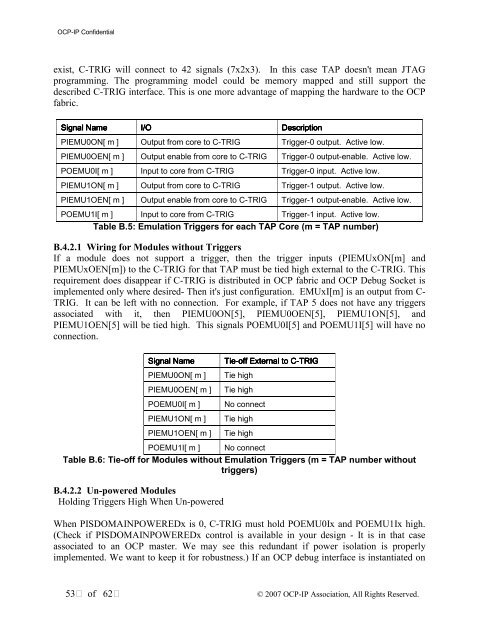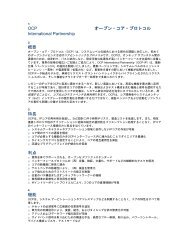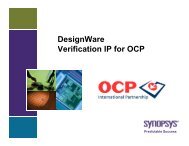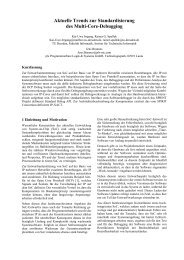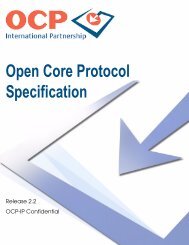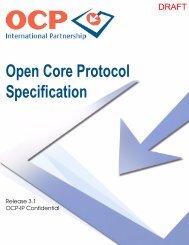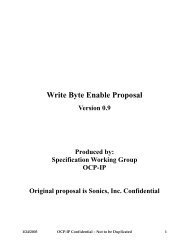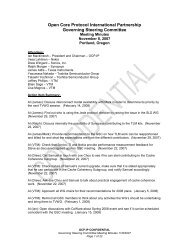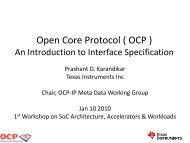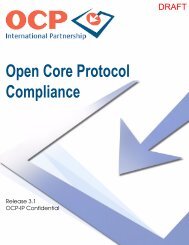Open Core Protocol Debug Interface Specification rev 1.0 - OCP-IP
Open Core Protocol Debug Interface Specification rev 1.0 - OCP-IP
Open Core Protocol Debug Interface Specification rev 1.0 - OCP-IP
Create successful ePaper yourself
Turn your PDF publications into a flip-book with our unique Google optimized e-Paper software.
<strong>OCP</strong>-<strong>IP</strong> Confidential<br />
exist, C-TRIG will connect to 42 signals (7x2x3). In this case TAP doesn't mean JTAG<br />
programming. The programming model could be memory mapped and still support the<br />
described C-TRIG interface. This is one more advantage of mapping the hardware to the <strong>OCP</strong><br />
fabric.<br />
Signal Name<br />
I/O<br />
Description<br />
PIEMU0ON[ m ] Output from core to C-TRIG Trigger-0 output. Active low.<br />
PIEMU0OEN[ m ] Output enable from core to C-TRIG Trigger-0 output-enable. Active low.<br />
POEMU0I[ m ] Input to core from C-TRIG Trigger-0 input. Active low.<br />
PIEMU1ON[ m ] Output from core to C-TRIG Trigger-1 output. Active low.<br />
PIEMU1OEN[ m ] Output enable from core to C-TRIG Trigger-1 output-enable. Active low.<br />
POEMU1I[ m ] Input to core from C-TRIG Trigger-1 input. Active low.<br />
Table B.5: Emulation Triggers for each TAP <strong>Core</strong> (m = TAP number)<br />
B.4.2.1 Wiring for Modules without Triggers<br />
If a module does not support a trigger, then the trigger inputs (PIEMUxON[m] and<br />
PIEMUxOEN[m]) to the C-TRIG for that TAP must be tied high external to the C-TRIG. This<br />
requirement does disappear if C-TRIG is distributed in <strong>OCP</strong> fabric and <strong>OCP</strong> <strong>Debug</strong> Socket is<br />
implemented only where desired- Then it's just configuration. EMUxI[m] is an output from C-<br />
TRIG. It can be left with no connection. For example, if TAP 5 does not have any triggers<br />
associated with it, then PIEMU0ON[5], PIEMU0OEN[5], PIEMU1ON[5], and<br />
PIEMU1OEN[5] will be tied high. This signals POEMU0I[5] and POEMU1I[5] will have no<br />
connection.<br />
Signal Name<br />
PIEMU0ON[ m ]<br />
PIEMU0OEN[ m ]<br />
POEMU0I[ m ]<br />
PIEMU1ON[ m ]<br />
PIEMU1OEN[ m ]<br />
POEMU1I[ m ] No connect<br />
Table B.6: Tie-off for Modules without Emulation Triggers (m = TAP number without<br />
triggers)<br />
B.4.2.2 Un-powered Modules<br />
Holding Triggers High When Un-powered<br />
Tie-off External to C-TRIG<br />
C<br />
Tie high<br />
Tie high<br />
No connect<br />
Tie high<br />
Tie high<br />
When PISDOMAINPOWEREDx is 0, C-TRIG must hold POEMU0Ix and POEMU1Ix high.<br />
(Check if PISDOMAINPOWEREDx control is available in your design - It is in that case<br />
associated to an <strong>OCP</strong> master. We may see this redundant if power isolation is properly<br />
implemented. We want to keep it for robustness.) If an <strong>OCP</strong> debug interface is instantiated on<br />
53 of 62<br />
© 2007 <strong>OCP</strong>-<strong>IP</strong> Association, All Rights Reserved.


